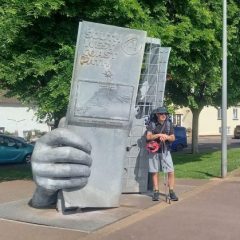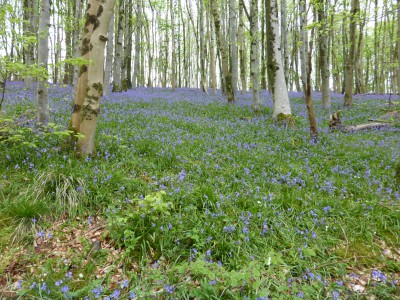25th August 2016: with Nick and Peter ‘Snablet’ MacNab.
Snablet is over from New Zealand to visit for a week before heading onto China to meet up with Mad Phil Rowsell to go caving there, so I gave him a call at his parent’s to invite on this evening’s trip.
We headed up to the top of Chamber 20 and along to the high route in the rift to clear the bang I had placed a fortnight ago. As we intend to put this dig on hold for a while I wanted to retrieve the wire as well. Snablet and Nick cleared the debris while I sorted out the wire, a good pile of rock was shifted and there is a decent face to continue the widening process when we return in the future.
That job done we headed back up to Chamber 20 and on to the area where the UBSS had been looking some while ago and there we did some furtling about.

Before deciding to have a poke at a different site in the same area. We cleared a large pile of loose rock from the spot until we were left with a number of much larger boulders that will require capping to reduce them into more manageable pieces.

We then had reached a natural pause and it was time to depart. A steady trip out of the cave, got changed and headed up to the Hunter’s Lodge Inn.
A fine way to spend my 60th birthday – caving with my friends!


 The hill fort is dated to the Iron Age and is bivallate on three sides but here on the south side there is a single rampart protected by the steep slope.
The hill fort is dated to the Iron Age and is bivallate on three sides but here on the south side there is a single rampart protected by the steep slope.
 The original entrance is suggested to be from the west side. The ramparts define an interior c.20 acres. There are a number of pillow mounds (medieval rabbit warrens) that overlie a pre-Medieval field system.
The original entrance is suggested to be from the west side. The ramparts define an interior c.20 acres. There are a number of pillow mounds (medieval rabbit warrens) that overlie a pre-Medieval field system. Perhaps one of the best known limestone karst features in the country with many excellent exposures of the Carboniferous Limestone, including Clifton Down Limestone, Cheddar Oolite, Cheddar Limestone, Burrington Oolite and Oxwich Head Limestone.
Perhaps one of the best known limestone karst features in the country with many excellent exposures of the Carboniferous Limestone, including Clifton Down Limestone, Cheddar Oolite, Cheddar Limestone, Burrington Oolite and Oxwich Head Limestone.  Over the years the origins of Cheddar Gorge has been the subject of many debates and is now suggested to be a fine example of a gorge cut by a surface river, rather than a collapsed cavern. The gorge has long been left high and dry as the drainage went underground.
Over the years the origins of Cheddar Gorge has been the subject of many debates and is now suggested to be a fine example of a gorge cut by a surface river, rather than a collapsed cavern. The gorge has long been left high and dry as the drainage went underground. Reference:
Reference: 



 9th May 2016: took a stroll from Blackrock Gate up to Longwood to admire the fine display of bluebells there.
9th May 2016: took a stroll from Blackrock Gate up to Longwood to admire the fine display of bluebells there.
 This metalwork hoard, probably of bronze/copper alloy was recently uncovered on a site in North Somerset. It was block lifted by yours truly and, subsequently dispatched to the county FLO to be further examined and fully excavated at a later date, as yet a report has not been published. The hoard is likely to be classified as type ‘founders’ hoard’ as it appears to consist mostly of scrap metal and might have been an ‘economic deposit’ placed in the ground by artisans for safekeeping and never recovered.
This metalwork hoard, probably of bronze/copper alloy was recently uncovered on a site in North Somerset. It was block lifted by yours truly and, subsequently dispatched to the county FLO to be further examined and fully excavated at a later date, as yet a report has not been published. The hoard is likely to be classified as type ‘founders’ hoard’ as it appears to consist mostly of scrap metal and might have been an ‘economic deposit’ placed in the ground by artisans for safekeeping and never recovered. The deposition of hoards is a phenomenon that occurs throughout the Middle and Late Bronze Age, thousands have been found across the British Isles. These hoards might be represented by a few objects, or there could be hundreds of pieces of metalwork in a range of forms that includes weapons, tools, ornamental items and scrap or broken metal.
The deposition of hoards is a phenomenon that occurs throughout the Middle and Late Bronze Age, thousands have been found across the British Isles. These hoards might be represented by a few objects, or there could be hundreds of pieces of metalwork in a range of forms that includes weapons, tools, ornamental items and scrap or broken metal. 23rd April 2016: In Harptree Combe ST 5618 5600.
23rd April 2016: In Harptree Combe ST 5618 5600.